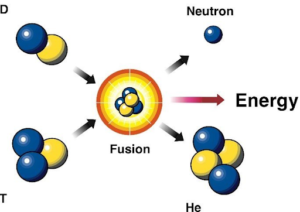In news- Recently, the nuclear scientists using lasers the size of three football fields said they had generated a huge amount of energy from fusion, possibly offering hope for the development of a new clean energy source.
Nuclear Fusion & Current breakthrough-
- Nuclear Fusion reactions power the Sun and other stars.
- It is a nuclear reaction in which atomic nuclei of low atomic number fuse to form a heavier nucleus with the release of energy.
- Nuclear Fusion is considered by some scientists to be a potential energy of the future, particularly because it produces little waste and no greenhouse gases.
- It differs from fission, a technique currently used in nuclear power plants, where the bonds of heavy atomic nuclei are broken to release energy.
- In the fusion process, two light atomic nuclei are “fused” to create a heavy one.

- In this experiment scientists used two isotopes of hydrogen, giving rise to helium.
- Researchers at the Lawrence Livermore National Laboratory in California appeared to have demonstrated “fusion ignition” for the first time roughly equivalent to striking a match that leads to a sustained fusion reaction of the kind seen at the centre of the sun.
- Scientists focused their giant array of almost 200 laser beams onto a tiny spot to create a mega blast of energy eight times more than they had ever done in the past.
- This is the process that is at work in stars, including the Sun.
- This is the most significant advance in inertial fusion since its beginning in 1972.
- Turning this concept into a renewable source of electrical power will probably be a long process and will involve overcoming significant technical challenges.
How does Nuclear fission work?
- In nuclear fission, atoms are split apart, which releases energy.
- A neutron collides with a uranium atom and splits it, releasing a large amount of energy in the form of heat and radiation.

- More neutrons are also released when a uranium atom splits.
- These neutrons continue to collide with other uranium atoms, and the process repeats itself over and over again.
- This process is called a nuclear chain reaction.
- This reaction is controlled in nuclear power plant reactors to produce a desired amount of heat.
















